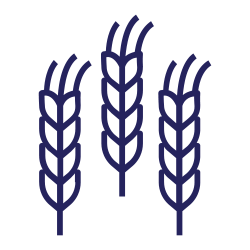Section Title
Seeding Cereals: How Early is too Early?
- Wheat
As spring approaches and soil temperatures begin to rise, everyone is getting excited for the upcoming growing season. Agronomists tend to agree that the benefits of early seeding are well recognized, but how early is too early? It’s tough, as “early” tends to be a moving target if one focuses solely on arbitrary calendar dates. While it’s not unrealistic for soil and weather conditions to allow Manitoba farmers to get into their fields in April, some years, the first week of May is more realistic.
Rewards
Much of the research done on seeding date in Western Canada indicates that earlier planting dates translate into yield benefits. Farmer reported data from Manitoba Agricultural Services Corporation (MASC) from 2010-2019 shows that earlier seeding dates consistently translate into higher yields.

Figure 1. The relative average yield reported by MASC during each seeding week for spring wheat and barley in Manitoba for the period of 2010-2019. The vertical axis represents the percentage of average yield, and the horizontal axis represents the week each crop is seeded.


Figure 2. 10-year average seeding date by municipality in Manitoba for barley (top) and spring wheat (bottom).
Factors that contribute to increased yield potential from earlier seeding:
- The crop has the potential to better utilize soil moisture throughout the growing season. Data from Environment Canada, collected in southwest MB has shown that the probability of utilizing total soil moisture, based on initial soil moisture is reduced from 50% if seeded May 1, to 36% if seeded May 22.
- Less weed competition.
- Reduced lodging potential, as later planted crops tend to be taller (increased internode length).
- Insect and disease pressure can be reduced if the crop is not at a susceptible stage when pests arrive.
- Potential to avoid heat damage at flowering. If the crop is heading out/ flowering earlier than mid-July, heat damage can be avoided.
- Improved harvest conditions, as early seeding usually results in earlier maturity and harvest.
Recent work, led by Dr. Brian Beres (AAFC-Lethbridge), demonstrated that farmers in Western Canada could benefit from seeding spring wheat based on soil temperature, rather than calendar dates. While no sites in MB were included in the study, optimal seeding time was found to be when soil temperatures were between 2 and 6°C, regardless of the calendar date. No detrimental effects were observed on grain yield, protein content, kernel weight or bulk density. In fact, seeding dates of February 16 (2016) and March 6 (2015) in Lethbridge were followed by over 30 days of temperature below 0°C with no negative effect on yield. The results from this study indicate that farmers across the Canadian prairies can seed wheat earlier, with less risk than holding off until soil temperatures reach 8-10°C.
In general, the greatest grain yield stability resulted from combinations of (a) earliest seeding dates, (b) high seeding rates, and (c) shallow seeding depths. If you plan on seeding ultra-early, it is recommended that high seeding rates (400-450 seeds/m2) and a dual seed treatment be used. These two factors increase yield stability and yield potential in an ultra-early seeding system. Results from the study can be found here. More information on how agronomic practices can increase yield and yield stability in ultra-early wheat seeding situations is available here.
Risks
When presented with the right conditions, many farmers will jump at the chance to get an early start. It’s hard to argue, as early seeding has been shown to favour yield improvements. Early seeding may not guarantee an advantage, but Beres’ research indicates you are unlikely to see a disadvantage.
Cereals are generally cold tolerant to temperatures as low as -6°C, since the growing point is located below the soil surface until the 5-leaf stage. However, the risk of plant death from temperatures dropping below -6°C is higher a bit later in the growing season, when the growing point is pushed closer to the soil surface. Prior to this point in the growing season, temperatures below -6°C will likely result in some leaf burn and then regrowth from the crown. Cooler temperature will slow the rate of germination and emergence. This can increase the risk of disease impacting survival. Applying a dual seed treatment has proven to be beneficial in these scenarios as they make the plant more resistant to abiotic stress.
So, how early is too early?
It’s a tough question to answer and varies between operations and location in the province. If the decision is made to wait until warmer soil temperatures, other aspects of the seeding operation to monitor include:
- Monitor soil temperatures, 14-day soil temperature histories from various regions of the province are available here.
- Assess ability to apply nitrogen fertilizer. For the 2021 growing season, nutrients can be applied starting March 23rd, with the requirement that farmers periodically check weather forecasts when applying fertilizer prior to April 11th. More information on nutrient management regulation can be found here. If conditions are favorable for early season N losses, consideration should be given to using an enhanced efficiency additive, or delaying a portion of total N supply until later in the season. Find our latest factsheet, looking at recently funded research to optimize N fertilizer management strategies for spring wheat in MB.
- Plan your seeding rate and adjust for seedling mortality if soil and weather conditions aren’t optimal for quick and even emergence. Find MCA’s latest article on target cereal plant stands here.
- Consider use of a dual insecticide/fungicide seed treatment if you haven’t already. Use of a dual seed treatment in combination with higher seeding rates (400-450 seeds/m2 or approximately 40-45 seeds/ft2) has been shown to increase yield stability in Western Canada. In addition to mitigating insects and fungal pathogens, they have also been demonstrated to increase stand and yield. Find the Manitoba Guide to Field Crop Protection here.
Additional Resources
- Risk vs. Reward: Seeding Early in Manitoba
- The Growing Point: Is your drill out yet? Ultra-early seeding proves successful in Western Canada
- Collier, G.R.S., Spaner, D.M., Graf, R.J.and Beres, B.L. (2020) The integration of spring and winter wheat genetics with agronomy for ultra-early planting into cold soils. Front. Plant Sci. 11:89.
- Collier GRS, Spaner DM, Graf RJ and Beres BL. 2021. Optimal Agronomics Increase Grain Yield and Grain Yield Stability of Ultra-Early Wheat Seeding Systems. Agronomy 11(2):240.









